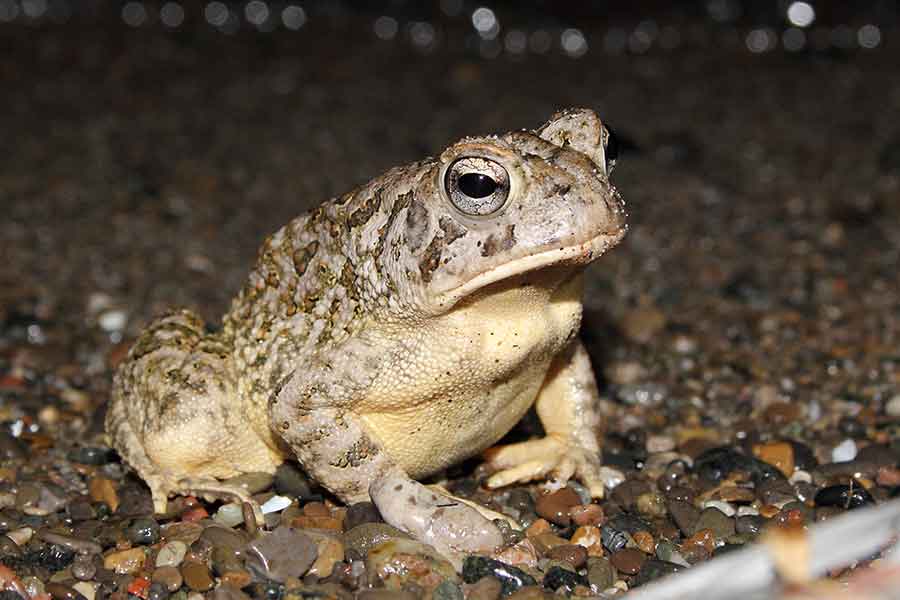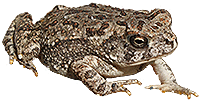Fowler’s Toad

Introduction
This chapter provides a review of progress toward protection and recovery of Fowler’s Toad in Ontario from 2007 to 2015.
Species information
Fowler’s Toad (Anaxyrus fowleri) is medium-sized toad that grows approximately five to eight centimetres long, not including its legs. Fowler’s Toad has gray or beige, textured skin on its back with darker patches and numerous small, dark brown warts. Fowler’s Toad has more than three warts on each darker patch which distinguishes it from other similar looking toad species. The underside of the species is white or cream coloured with either no spots or a single dark spot between its forelimbs. In addition, males have a dark coloured throat, whereas females have an entirely white underside and throat. Fowler’s Toad has a distinct mating call that has been described as a prolonged, shrill scream.
In Ontario, Fowler’s Toad only exists at various locations along Lake Erie, within a half a kilometre from the shoreline. Fowler’s Toad does not exist anywhere else in Canada. The species requires several different habitats throughout its lifecycle. For feeding, the species requires shoreline habitat such as bedrock outcrops, dunes and beaches. For breeding, egg laying and tadpole development, Fowler’s Toad requires wetlands with little vegetation, bedrock pools, stream mouths that open onto sand beaches or shallow bays or ponds with a sand or bedrock bottom. For hibernation, the species requires sand dunes with little vegetation and deep sand. To migrate between hibernation and breeding sites, Fowler’s Toad needs continuous beaches and sand dunes with no solid barriers, such as piers, roads or fast-moving water.
Fowler’s Toad faces several threats to its survival and recovery, the most significant being habitat loss and degradation. The species' habitat may be lost or degraded due to barriers on beaches, such as breakwalls, increased plant growth, beach grooming, vehicle use on beaches and sand dunes, removal of dunes for development and the spread of invasive species, such as European Common Reed (Phragmites australis ssp. australis), which cause breeding habitat to become unsuitable for Fowler’s Toad.
The survival and recovery of Fowler’s Toad are influenced by other factors as well. Because individual Fowler’s Toads only live up to five years their population sizes can vary greatly from year to year. Because Fowler’s Toad populations in Ontario are small and relatively far from one another, they tend to have low genetic diversity. This may impact their ability to recover because less genetically diverse populations are more vulnerable to threats.
Fowler’s Toad is listed as endangered at both the provincial (Species at Risk in Ontario List) and the federal (Schedule 1 under the Species at Risk Act) levels. Globally, it is considered to be secure.
Provincial status
Prior to the Endangered Species Act, 2007 (ESA or "the Act") the Committee on the Status of Species at Risk in Ontario (COSSARO) assessed Fowler’s Toad as threatened. It was listed on the Species at Risk in Ontario List as threatened in 2000 and retained this status when the ESA came into force in 2008. COSSARO then re-assessed Fowler’s Toad as endangered and the status of the species was altered on the Species at Risk in Ontario List in 2010. In future assessments, COSSARO may consider information gained through protection and recovery actions regarding the species' threats and trends in population and distribution.
Species and habitat protection
Protecting Fowler’s Toad and its habitat are key components in the implementation of the ESA, and continue to be government-led actions, as identified in the government response statement. Fowler’s Toad has been protected from being killed, harmed, harassed, captured or taken under the ESA since it came into force in 2008. In addition, the species' habitat has been protected from being damaged or destroyed since 2010. Habitat protection for the species was initially based on the general habitat definition in the ESA. The habitat of Fowler’s Toad is now protected through a habitat regulation that came into force in 2014. Fowler’s Toads also receive protection as a Specially Protected amphibian under Schedule 10 of the Fish and Wildlife Conservation Act, 1997 (FWCA).
Fowler`s Toad has been protected from being killed, harmed, harassed, captured or taken since the ESA came into force in 2008.
In addition, the habitat of Fowler`s Toad has been protected from being damaged or destroyed since 2010. Habitat protection was initially based on the general habitat definition in the ESA. The habitat of Fowler`s Toad is now protected through a habitat regulation that came into force in 2014.
The government posted the habitat regulation (Ontario Regulation 242/08, section 27.0.2) for Fowler’s Toad on December 17, 2013. Additional time was required to develop this regulation in order to consider the recommendations in the federal government’s recovery strategy for the species which was published in January 2013. A notice was posted on the Environmental Registry to notify the public about the need for additional time. The habitat regulation provides clarity to the public and others on what areas are protected as Fowler’s Toad habitat. The regulated habitat includes areas that are required by the species to carry out its life processes (e.g., breeding, egg laying and tadpole development) within its range in Ontario. The habitat regulation was developed based on information regarding the habitat needs of the species as well as social and economic factors, collected from a variety of sources including comments received through public consultation.
Any person who negatively impacts Fowler’s Toad or its habitat without prior authorization may be prosecuted under the ESA.
Recovery strategy
A recovery strategy for Fowler’s Toad was published on February 18, 2011, which was in advance of the date required by the ESA. Recovery strategies are advice to government and represent the best available scientific knowledge. The strategy identifies the habitat needs of Fowler’s Toad and the threats it faces, while recommending objectives and approaches for protecting and recovering the species. The recovery strategy also includes recommendations on the areas of habitat to be considered in the development of a habitat regulation.
Government response statement
The Ministry of Natural Resources and Forestry ("the Ministry") published the government response statement (GRS) for Fowler’s Toad on November 18, 2011, which was within the timeframe required by the ESA. The GRS is government policy that contains the Government of Ontario’s goal for the recovery of Fowler’s Toad.
To help achieve this goal, the government leads and supports recovery actions identified in the GRS. Common actions for the government to lead as it works toward achieving a species' recovery goal are provided in section 2.5 of the Species at Risk Program Status (2008-2015). One specific action for the government to lead to help protect and recover Fowler’s Toad is:
Recovery goal
The government’s goal for the recovery of Fowler’s Toad is to maintain populations at existing locations in Ontario, and to investigate the feasibility of re-introducing populations in other suitable areas.
- Develop a survey protocol to be used by proponents and partners to detect the presence or absence of Fowler’s Toad.
The GRS for Fowler’s Toad also lists seven actions the Ministry supports others to undertake for the species. These government-supported actions fall under the objectives identified in the GRS, which are:
- Protect existing Fowler’s Toad populations and habitat, reduce or mitigate human impacts to them and improve habitat areas; and
- Improve knowledge of Fowler’s Toad biology, habitat and threats and potential approaches to mitigate these impacts.
The subsequent sections of this chapter provide a review of actions that the government has led or supported to help achieve the recovery goal for Fowler’s Toad.
Government funded projects
An important government-led action in the GRS for Fowler’s Toad is to support partners to undertake activities to protect and recover the species. Through the Species at Risk Stewardship Fund the Ministry has supported a total of 19 projects ($870,403) designed to contribute to the protection and recovery of Fowler’s Toad. All of these projects targeted multiple species at risk, including Fowler’s Toad. Partners also reported that they were successful in securing additional funding ($1,291,497) from other sources. This amount includes additional funding and in-kind support in the form of time and expertise provided by volunteers.
Stewardship partners reported that provincial funding helped them to secure in-kind support by involving 5,281 individuals who volunteered 31,844 hours of their time toward protection and recovery activities for multiple species at risk, including Fowler’s Toad, which has an estimated value of $624,955. The stewardship partners also reported that through their efforts and the efforts of their volunteers to implement actions contained in the GRS, they were successful in enhancing 121 hectares of habitat to benefit Fowler’s Toad at Long Point, Ontario. In addition, the partners reported providing outreach to multiple species at risk, including Fowler’s Toad, to 14,066 individuals.
Ontario’s Invasive Species Act
The GRS for Fowler’s Toad indicates that invasive species pose a threat to the survival and recovery of the species in Ontario. The provincial Invasive Species Act, 2015 came into force on November 3, 2016 and provides an enabling framework to support the prevention, detection and control of invasive species in Ontario. This framework may support actions to reduce the threats of invasive species on native and at-risk species, including Fowler’s Toad.
The Ministry also supports proponents in conducting research that addresses important knowledge gaps for species at risk. Through the Species at Risk Research Fund for Ontario, the Ministry provided funding to a total of four projects to monitor the species using a new photo recognition tool and to conduct research on Fowler’s Toad demographics, natural limiting factors, habitat use and dynamics as well as the feasibility of artificially breeding the species.
The remainder of this section highlights a multi-year project supported through the Species at Risk Research Fund for Ontario and the Species at Risk Stewardship Fund and the corresponding government-supported recovery actions.
A multi-year research project conducted through McGill University has significantly supported several actions listed in the government response statement for Fowler’s Toad. From 2011 to 2015, Dr. Green received funding from the Species at Risk Research Fund as well as the Species at Risk Stewardship Fund to investigate if artificial breeding ponds are effective for raising Fowler’s Toad in order to help recover the species' population at Long Point, Ontario. In 2013, the Canadian Wildlife Service installed artificial breeding ponds at Long Point. Dr. Green and his team have successfully raised hundreds of Fowler’s Toad tadpoles in the artificial ponds and monitored the population to determine what effect the artificial ponds have on the toad’s breeding success, juvenile growth and survival rate. Dr. Green and his team, in partnership with MNRF staff at Long Point Provincial Park, created an additional wetland for Fowler’s Toad breeding. Studies by Dr. Green and others have found that the artificial ponds significantly benefited the Long Point population and that survival rates in the artificial breeding ponds were as good as or better than natural survival rates reported by other studies. Importantly, one of these studies found that in 2013 only one other water body within a 10 kilometre radius of Dr. Green’s study site was used for breeding; this was due to loss of breeding habitat as a result of invasive European Common Reed. Therefore, the number of juvenile toads produced in 2013 would have been much lower if the artificial ponds had not been created. Dr. Green has also received funding from MNRF to develop a new method for Fowler’s Toad mark-recapture studies that uses photo recognition software to identify recaptured toads without physically marking the toads. The software is now being used by Dr. Green’s team as well as MNRF staff to monitor the species. All of the research described above is part of a long term study of Fowler’s Toad that Dr. Green has been directing for close to 30 years. These studies are still ongoing. By determining how to effectively raise the species and the positive effect this has on the species' population, the above research has made considerable progress toward the GRS action of determining the feasibility of reintroducing Fowler’s Toad into suitable areas. In addition, this research has contributed to progress toward the GRS actions of developing and implementing a standard monitoring program to track changes in species distribution and abundance, and conducting research to better understand Fowler’s Toad demographics, natural limiting factors, habitat use and dynamics.
MNRF monitoring and outreach
In addition to funding numerous stewardship and research projects, the Ministry has carried out a significant amount of monitoring and outreach work for the species. MNRF has undertaken monitoring efforts for Fowler’s Toad at each of its three known locations - Rondeau, Long Point and Niagara. Ontario Parks staff at Rondeau Provincial Park carry out an annual monitoring program for Fowler’s Toad. The program collects mark-recapture data using photo recognition technology to estimate the size of the Fowler’s Toad population. In the Niagara region, MNRF district staff have surveyed and collected monitoring data for multiple beaches where Fowler’s Toad has been known to exist or where the species' may exist but has not yet been observed. This includes breeding call and mark-recapture surveys as well as hibernation studies. These surveys have taken place for numerous years and remain ongoing. Some hibernation and breeding sites in the Niagara region have also been mapped for the species. More work is underway to map these important habitat features. These efforts support the species' GRS actions to develop and implement a standard monitoring program to track changes in species distribution and abundance and to conduct research to better understand Fowler’s Toad demographics, natural limiting factors, habitat use and dynamics, and the impact of human activities.
MNRF staff with Guelph District and Ontario Parks also conduct outreach and education activities for various stakeholders as well as students that live near Fowler’s Toad populations. Staff at Rondeau Provincial Park host regular outreach and education events on Fowler’s Toad through the Park’s Natural Heritage Education program which includes programing on local species at risk. The Park has also undertaken a large education campaign related to Fowler’s Toad and boat storage on dunes to address boats being stored in proximity to known Fowler’s Toad habitat. To protect Fowler’s Toad from recreational activities, the Park has also fenced off a known breeding pond. MNRF staff in Guelph District carry out outreach activities for homeowners and students at schools and various community events. The District has even created a Fowler’s Toad costume in order to increase engagement at outreach events. The costume is lent to parks, nature groups and other organizations. These actions have helped to make progress on the following GRS actions for the species: to deliver effective communications and outreach to key stakeholders and landowners within the existing range of Fowler’s Toad to increase awareness of the species' distribution and threats, and to foster good stewardship and to implement best management practices for habitat restoration, including beach management (e.g., actions related to barriers and beach grooming).
Species at Risk Stewardship Fund
-
 $0
$0for Fowler’s Toad exclusively
-
 $870,403
$870,403for multi-species projects that included Fowler’s Toad
-
 $1,291,497
$1,291,497in additional funding and in-kind support
-
 19
19projects included the Fowler’s Toad
-
 5,281
5,281volunteers
-
 31,844
31,844volunteer hours
-
 121
121hectares of habitat enhanced
-
 14,066
14,066people received outreach
Efforts to minimize adverse effects on Fowler’s Toad
Supporting partners through permits and their associated conditions, is an important government-led action. A total of eight permits have been issued for Fowler’s Toad since the species was protected under the ESA. Five of the eight permits were issued for activities that focused exclusively on Fowler’s Toad and three were issued for activities that focused on multiple species at risk, including Fowler’s Toad. All eight of these permits have been 'protection or recovery permits' (i.e., 17(2)(b) permit). Protection or recovery permits are issued if the purpose of the activity is to assist the protection or recovery of a species at risk. These permits enabled several surveys to better understand the habitat requirements of Fowler’s Toad and how the species uses its habitat, including dispersal characteristics and home range requirements. Three of the eight permits also enabled projects to help better understand the distribution of the species in Ontario.
A total of seven agreements were entered into for Fowler’s Toad. These agreements were enabled through Ontario Regulation 242/08 (prior to the July 1, 2013 amendment). Conditions of the agreements involve implementing actions in the mitigation plan, including, but not limited to:
- Training on-site workers on handling species at risk and being aware of species;
- Minimizing adverse effects (e.g., specific activities have been identified which should not occur in a sensitive area during a sensitive period due to likelihood of impact, including minimizing water level draw downs and de-watering of sensitive areas during sensitive periods); and
- Monitoring and reporting on implementation of mitigation measures.
Two activities that may affect Fowler’s Toad or its habitat have been registered under 'Species protection, recovery activities' (section 23.17) and 'Drainage works' (section 23.9) of Ontario Regulation 242/08 under the ESA, and include an ongoing reptile conservation project at Rondeau Provincial Park and municipal drainage work. These registrations require the registered individual to comply with all conditions of the regulation, such as:
- Implementing the actions in a mitigation plan developed by an expert on the species to help minimize or avoid any adverse effects;
- Ensuring that any person carrying out any part of the activity receives training on how to identify the species and its habitat, potential threats posed to the species and its habitat by the activity, and the steps that must be taken to minimize any adverse effects;
- Updating mitigation plans every five years to include information obtained while monitoring the effects of the activity;
- Reporting observations of the species to the Ministry using the Rare Species Reporting Form; and
- Preparing a report following completion of the activity that provides a summary of the outcomes of the activity, including a detailed assessment of the extent to which the activity achieved its purpose.
-
8protection or recovery permits
-
7agreements
-
2registrations
Guides and resources for Fowler’s Toad
The Species at Risk Guides and Resources Toolbox is an electronic library of best management practices (BMPs) and technical resources to assist proponents and practitioners in meeting the requirements of the ESA and its regulations. MNRF has recently developed a new BMP document for inclusion in the toolbox.
In 2013, the Ministry developed guidance on 'Reptile and Amphibian Exclusion Fencing: Best Practices' to assist landowners, conservation practitioners and environmental consultants to reduce the threats that roadways and associated roadwork pose on amphibians and reptile species at risk and their habitat. More recently, the Ministry has led the development of 'Best Management Practices for Mitigating the Effects of Roads on Amphibian and Reptile Species at Risk in Ontario'. This document builds on the previous guidance by providing information on exclusion fencing as well as a number of other topics including: the impacts of roads, recommended processes and considerations for avoiding and mitigating impacts, crossing structures, monitoring techniques and supplementary mitigation measures. To migrate between hibernation and breeding sites, Fowler’s Toad needs continuous beaches and sand dunes with no solid barriers, such as piers or roads. These documents provide guidance to help protect Fowler’s Toad from barriers in order to maintain a continuous habitat for the species. The actions in the guidance also address part of a high priority GRS action for the species by developing and implementing best management practices for actions related to barriers and beach grooming.
Occurrences of Fowler’s Toad in Ontario
Natural Heritage Information Centre (NHIC)
Six populations
The six extant populations of Fowler’s Toad are located in Rondeau and Long Point Provincial Parks and a stretch of the Lake Erie coast near Niagara from James N. Allan Provincial Park to Port Colbourne. Although these populations are extant, two of the three face significant threats. At Long Point, invasive European Common Reed is taking over Fowler’s Toad breeding habitat (Greenberg and Green 2013). At Rondeau, the Fowler’s Toad population is threatened by bank erosion which impacts the species' habitat. Erosion at Rondeau is causing Fowler’s Toad to move to other areas of the Park where the toads are more vulnerable to people who use the beach for recreation (M. Cairns pers. comm. 2016). To address these threats, more work needs to be done for several of the species' GRS actions.
Fowler’s Toad populations at Rondeau Provincial Park, James N. Allan Provincial Park and Port Colbourne are monitored by MNRF staff and the Long Point population is monitored by Dr. David Green and his team. These monitoring efforts have led to a large number of observation records for the species. Since 2008, the Ministry has received approximately 25,000 records of the species. These records are based on observations between 1980 and 2013 and come from a variety of sources. This relatively high number of recorded observations is due to the fact that Fowler’s Toad is very easy to survey for and has been surveyed at each of its locations multiple times each year since 2008. Because these surveys are generally done several times throughout the species' breeding season, the majority of toads would be counted several times, which results in a high number of recorded observations for the species.
Submissions of observations help to redefine where the species is known to occur. Although a large number of observations have been submitted for the species, no new populations of the species have been found since 1985. It is possible that there are observations of Fowler’s Toad that have not been submitted to the Ministry. Encouraging the submission of observations of Fowler’s Toad to the Ministry is included in the GRS as a government-led action.
Everyone is encouraged, or may be required by an authorization or approval, to submit observations of the Fowler’s Toad, as well as every other species at risk, to the Ministry’s Natural Heritage Information Centre for incorporation into the provincial record of observations.
25,000 Observations of this species were submitted to the NHIC since 2008.
Summary of progress toward the protection and recovery of Fowler’s Toad (2007 to 2015)
Provincial status:
- Fowler’s Toad is classified as endangered under the Endangered Species Act, 2007(ESA). Prior to its transition to the ESA, Fowler’s Toad was listed as threatened, but was not regulated under the previous Endangered Species Act. It was re-assessed as endangered andits status was updated on the Species at Risk List in 2010. The species has been protected from being killed, harmed, harassed, captured or taken under the ESA since it came into force in 2008, and its habitat has been protected from damage or destruction since 2010. In 2014, the government developed a habitat regulation for the species.
Species-specific documents and guidance published by the government:
- Recovery Strategy for Fowler’s Toad (2011)
- Fowler’s Toad: Ontario Government Response Statement (2011)
- Fowler’s Toad Habitat Regulation (Ontario Regulation 242/08; 2014)
Government-supported stewardship projects:
- Through the Species at Risk Stewardship Fund, the Ministry of Natural Resources and Forestry ("the Ministry") has enabled its stewardship partners to conduct a total of 19 projects ($870,403) that have supported the protection and recovery of multiple species at risk, including Fowler’s Toad.
- The Ministry’s support helped its stewardship partners to involve 5,281 individuals who volunteered 31,844 hours of their time toward protection and recovery activities for species at risk, including Fowler’s Toad. The estimated value of these voluntary contributions, as well as additional funding and in-kind support, is $1,291,497.
- Stewardship partners reported that through their actions 121 hectares of habitat were enhanced for Fowler’s Toad and other species at risk that inhabit the same ecosystem.
- Stewardship partners reported providing outreach on multiple species at risk, including Fowler’s Toad to 14,066 individuals.
Supporting human activities while ensuring appropriate support for species recovery:
- The Ministry has issued eight permits for this species. All eight of these permits have been 'protection and recovery permits' issued under clause 17(2)(b) of the ESA.
- A total of seven agreements were entered into for Fowler’s Toad. These agreements were enabled through Ontario Regulation 242/08 (prior to the July 1, 2013 amendment).
- Two activities have been registered for this species. The two activities are registered under 'Species protection, recovery activities' (section 23.17) and 'Drainage works' (section 23.9) of Ontario Regulation 242/08 under Ontario Regulation 242/08 of the ESA.
Occurrences and distribution:
- Thirteen populations of Fowler’s Toad have been documented in southwestern Ontario. Currently, of these populations six are extant, four are considered historical and three are considered extirpated.
Summary of progress toward meeting the recovery goal
Summary of progress
Progress has been made on all government-led and government-supported actions outlined in the GRS for Fowler’s Toad. The Government of Ontario has directly undertaken actions to:
- Encourage submission of Fowler’s Toad data to the Natural Heritage Information Centre;
- Protect the species through the ESA and its habitat through a habitat regulation;
- Support partners to undertake activities to protect and recover the species;
- Establish and communicate annual priority actions for support;
- Educate other agencies and planning authorities on the requirement to consider the protection of the species and its habitat; and
- Undertake communications and outreach to increase public awareness of species at risk in Ontario.
The Government of Ontario has specifically committed to develop a survey protocol to be used by proponents and partners to detect the presence or absence of Fowler’s Toad. MNRF has made progress toward this action by giving guidance on survey methodology for Fowler’s Toad during an annual reptile and amphibian field training course for consultants, government staff and other interested individuals.
Government-supported actions are organized under over-arching recovery objectives. Progress has been made toward all of the government-supported recovery objectives and the associated actions that are identified in the GRS for Fowler’s Toad.
Under the objective to protect existing Fowler’s Toad populations and habitat, reduce or mitigate human impacts to them and improve habitat areas, progress has been made for two of the three actions:
- Develop and implement best management practices based on an evaluation of current habitat restoration approaches. Practices may include: habitat improvement (e.g., removal of invasive species such as European Common Reed and Zebra Mussels from breeding sites and dunes), and beach management (e.g., actions related to barriers and beach grooming) (Action No. 1; High Priority); and
- Deliver effective communications and outreach to key stakeholders and landowners within the existing range of Fowler’s Toad to increase awareness of the species' distribution and threats, and to foster good stewardship (Action No. 2).
These actions have been implemented through numerous projects supported by the Species at Risk Stewardship Fund. The Ministry has also made progress toward the first action by developing best management practices for mitigating the effects of roads on amphibians and reptile species at risk in Ontario. These documents provide guidance for mitigating the effect of barriers, which is beneficial for implementing best management practices for beach management. These documents are available publically on the Species at Risk Guides and Resources Toolbox electronic library.
Under the objective to improve knowledge of Fowler’s Toad biology, habitat and threats and potential approaches to mitigate these impacts, considerable progress has been made toward all of the actions:
- Develop and implement a standard monitoring program to track changes in species distribution and abundance (Action No. 4; High Priority);
- Undertake population viability assessment (PVA): determine data needs and use of PVA, conduct research required for the PVA, and carry out the assessment once the information is available (Action No. 5); and
- Conduct research to better understand Fowler’s Toad demographics, natural limiting factors, habitat use and dynamics, and the impact of human activities such as pollution discharge or construction of shoreline structures on the species and habitat (Action No. 6).
These actions have been implemented by several projects funded through the Species at Risk Research Fund for Ontario and the Species at Risk Stewardship Fund as well as conditions of multiple 'protection and recovery' permits.
The recovery goal for Fowler’s Toad is to maintain populations at existing locations in Ontario and to investigate the feasibility of re-introducing populations in other suitable areas. Effort made toward the government-led and government-supported GRS actions has helped to make progress toward this goal. For example, the Canadian Wildlife Service (CWS), MNRF and Dr. Green’s team have made progress toward maintaining Fowler’s Toad populations at Long Point by installing artificial breeding ponds for the species. Much of the Fowler’s Toad breeding habitat at Long Point has been destroyed due to invasive European Common Reed. Artificial ponds benefit Fowler’s Toad by replacing some of the breeding habitat that has been lost to European Common Reed. MNRF staff at Rondeau Provincial Park have also made progress toward maintaining populations of Fowler’s Toad by fencing off an area of the beach to protect a breeding pond. Projects funded through the Species at Risk Research Fund for Ontario have made progress toward determining whether it is feasible to raise Fowler’s Toads in artificial breeding ponds. Dr. David Green has raised hundreds of tadpoles in artificial breeding ponds and researched breeding success, juvenile growth and survival rate of these toads. Artificially raising tadpoles has helped maintain the Fowler’s Toad population at Long Point. This work has helped to determine the feasibility of reintroducing the species into suitable areas by determine the viability of augmenting Fowler’s Toad populations. However, as described in section 10, Fowler’s Toad populations continue to be threatened by invasive European Common Reed and bank erosion, which impacts the species' habitat and, in some cases, forces the toads to move to areas where they are more vulnerable to people.
Recommendations
As stated in the GRS, the review of progress toward protecting and recovering Fowler’s Toad can be used to help identify whether adjustments are needed to achieve the protection and recovery of the species. Based on progress to-date, the overall direction provided in the GRS for Fowler’s Toad should continue to guide protection and recovery actions for the species, particularly for those actions identified as high priority in the GRS. Relative to actions that have received a high level of support, the following actions have received support to a lesser degree and may be considered in future decisions regarding the protection and recovery of the species:
- Although progress has been made toward developing and implementing best management practices , including habitat improvement and beach management, (Action 1; High Priority) at Rondeau and Long Point Provincial Park, further work is required to implement best management practices at all known locations of Fowler’s Toad. In particular, much work is needed to address the threat of European Common Reed for the Long Point population and the impact of recreational activities on beaches for the Rondeau population. These threats must be addressed in order to maintain populations at existing locations in Ontario.
- Initial progress has been made toward undertaking population viability assessments (Action No. 5), more work is required for populations that have not been assessed (i.e., James N. Allan Provincial Park, Port Colbourne and Long Beach).
- Actions for which progress has been limited should be supported in future implementation planning, such as supporting the securement of lands that contain Fowler’s Toad populations through existing land securement and stewardship programs (Action No. 3); and determine the feasibility of reintroducing Fowler’s Toad into suitable areas (Action No. 7).
Moving forward, protecting and recovering Fowler’s Toad will continue to be a shared responsibility that will require the involvement of many individuals, organizations and communities. Financial support for the implementation of actions may be available through the Species at Risk Stewardship Fund or the Species at Risk Research Fund for Ontario. The Ministry can also advise if any authorizations under the ESA or other legislation may be required to undertake a project. By working together, progress can continue to be made toward protecting and recovering Fowler’s Toad in Ontario.
Related information
- Categorizing and Protecting Habitat under the Endangered Species Act
- Habitat Regulation Summary for Fowler’s Toad
- Natural Heritage Information Centre
- Ontario’s Endangered Species Act
- Ontario’s Endangered Species Act Regulation 242/08
- Ontario Recovery Strategy and Government Response Statement for Fowler’s Toad
- Policy Guidance on Harm and Harass under the Endangered Species Act
- Species at Risk in Ontario List
- Species at Risk Stewardship Fund
References
Cairns, Melody. Personal communication. 2016. Southwest Park Zone Ecologist. Ministry of Natural Resources and Forestry.
COSEWIC. 2010. COSEWIC assessment and status report on the Fowler’s Toad Anaxyrus fowleri in Canada. Committee on the Status of Endangered Wildlife in Canada. Ottawa. vii + 58 pp.
Greenberg, D.A. and D.M. Green. 2013. Effects of an invasive plant on population dynamics in toads. Conservation Biology 27:1049-1057.
Footnotes
- footnote[1] Back to paragraph A population is defined as an area of land and/or water on/in which an element (i.e., Fowler’s Toad) is or was present. They are comprised of one or more observations and the area has a practical conservation value as it is important to the conservation of the species. An element occurrence is the technical term used to describe this.
- footnote[2] Back to paragraph A population is considered historical if it has not been recorded within the last 20 years. Historical populations may still exist, but updated information is not available.